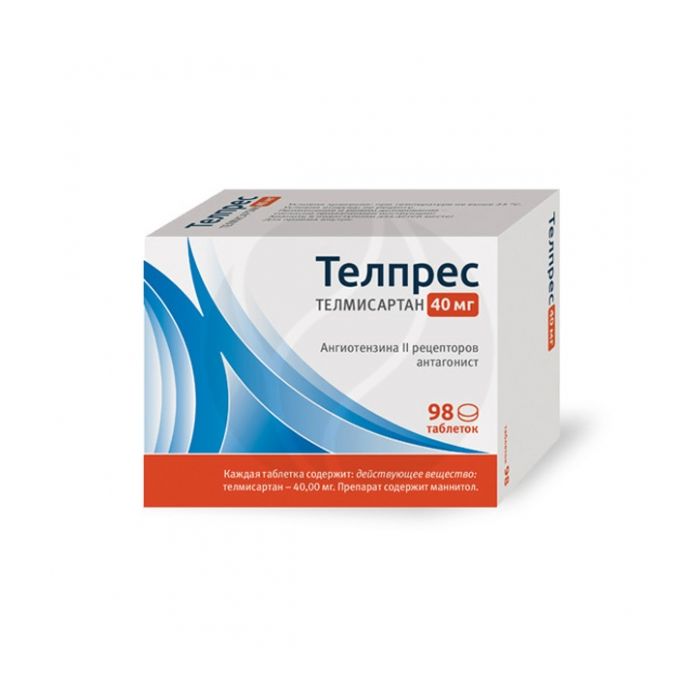Telpres tablets 40mg, No. 98
Expiration Date: 05/2027
Russian Pharmacy name:
Телпрес таблетки 40мг, №98
Arterial hypertension.
For adults, the daily dose is 20-40 mg (1 time / day). In some patients, the hypotensive effect can be achieved at a dose of 20 mg / day. If necessary, the dose can be increased to 80 mg / day.
Patients with impaired renal function, as well as elderly patients, do not require dose adjustment.
For patients with impaired liver function, the daily dose is 40 mg.
Active substance: Telmisartan
Obstruction of the biliary tract, severe liver and kidney dysfunction, pregnancy, lactation (breastfeeding), hypersensitivity to telmisartan.
pharmachologic effect
Antihypertensive agent, angiotensin II receptor antagonist (AT1 type). It has a very high affinity for this receptor subtype. Selectively and long-term binding to receptors, telmisartan displaces angiotensin II from the connection with AT1 receptors. Does not show affinity for other subtypes of AT receptors. The functional significance of other receptor subtypes and the effect of increased (as a result of the administration of telmisartan) levels of angiotensin II on them is not known. Telmisartan reduces the level of aldosterone in blood plasma, does not inhibit plasma renin, does not block ion channels, does not inhibit ACE (kinase II), which also destroys bradykinin. Therefore, the manifestations of side effects associated with bradykinin are not observed.
Indications of the active substances of the drug
Arterial hypertension.
Dosage regimen
For adults, the daily dose is 20-40 mg (1 time / day). In some patients, the hypotensive effect can be achieved at a dose of 20 mg / day. If necessary, the dose can be increased to 80 mg / day.
Patients with impaired renal function, as well as elderly patients, do not require dose adjustment.
For patients with impaired liver function, the daily dose is 40 mg.
Side effect
From the side of the central nervous system: headache, dizziness, fatigue, insomnia, anxiety, depression, convulsions.
From the digestive system: abdominal pain, dyspepsia, nausea, diarrhea, increased activity of hepatic transaminases.
From the respiratory system: cough, pharyngitis, upper respiratory tract infections.
On the part of the hematopoietic system: a decrease in the level of hemoglobin.
Allergic reactions: rash; in a single case - angioedema.
From the urinary system: peripheral edema, urinary tract infections, increased uric acid levels, hypercreatininemia.
From the side of the cardiovascular system: a marked decrease in blood pressure, palpitations, chest pain.
From the musculoskeletal system: back pain, myalgia, arthralgia.
On the part of laboratory parameters: hyperkalemia, anemia, hyperuricemia.
Others: flu-like syndrome.
Contraindications for use
Obstruction of the biliary tract, severe liver and kidney dysfunction, pregnancy, lactation (breastfeeding), hypersensitivity to telmisartan.
Application during pregnancy and lactation
Telmisartan is contraindicated during pregnancy and lactation (breastfeeding).
Application for violations of liver function
Contraindicated in severe liver dysfunction.
Application for impaired renal function
Contraindicated in severe renal impairment.
Application in children
There are no data on the safety and efficacy of telmisartan in children and adolescents.
Use in elderly patients
Elderly patients do not need dose adjustment.
special instructions
Telmisartan is used with caution for violations of liver function, gastric ulcer and duodenal ulcer in the acute stage, other diseases of the gastrointestinal tract, stenosis of the aorta and mitral valve, obstructive hypertrophic cardiomyopathy, ischemic heart disease, heart failure.
In patients with bilateral renal artery stenosis or renal artery stenosis of a single functioning kidney, the use of telmisartan increases the risk of severe arterial hypotension and renal failure. Therefore, telmisartan should be used with caution in this category of patients.
During the period of telmisartan use in patients with impaired renal function, it is necessary to control the content of potassium and creatinine in the blood plasma.
There are currently no data on the use of telmisartan in patients with a recent renal transplant.
In patients with reduced BCC and / or hyponatremia, symptomatic arterial hypotension may occur, especially after taking the first dose of telmisartan. Therefore, before therapy, it is necessary to correct such conditions.
It is not recommended to use telmisartan in patients with primary aldosteronism, because such patients are insensitive to drugs that affect the renin-angiotensin system.
The use of telmisartan is possible in combination with thiazide diuretics, because this combination provides an additional reduction in blood pressure.
When considering the possibility of increasing the dose of telmisartan, it should be remembered that the maximum antihypertensive effect is usually achieved 4-8 weeks after the start of treatment.
Use in pediatrics
There are no data on the safety and efficacy of telmisartan in children and adolescents.
Influence on the ability to drive vehicles and use mechanisms
The question of the possibility of engaging in potentially hazardous activities that require increased attention and rapid psychomotor reactions should be resolved only after assessing the individual reaction to telmisartan.
Drug interactions
With simultaneous use with antihypertensive drugs, an increase in the antihypertensive effect is possible.
With simultaneous use with potassium-sparing diuretics, heparin, dietary supplements, salt substitutes containing potassium, hyperkalemia may develop.
With simultaneous use with lithium preparations, an increase in the concentration of lithium in the blood plasma is possible.
With simultaneous use, it is possible to increase the concentration of digoxin in the blood plasma.

